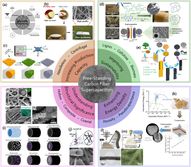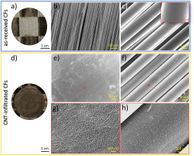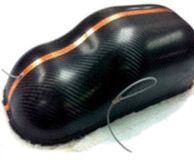BibTex format
@article{Shirshova:2014:10.1039/c4fd00055b,
author = {Shirshova, N and Qian, H and Houlle, M and Steinke, JHG and Kucernak, ARJ and Fontana, QPV and Greenhalgh, ES and Bismarck, A and Shaffer, MSP},
doi = {10.1039/c4fd00055b},
journal = {Faraday Discussions},
pages = {81--103},
title = {Multifunctional structural energy storage composite supercapacitors},
url = {http://dx.doi.org/10.1039/c4fd00055b},
volume = {172},
year = {2014}
}
RIS format (EndNote, RefMan)
TY - JOUR
AB - This paper addresses the challenge of producing multifunctional composites that can simultaneously carry mechanical loads whilst storing (and delivering) electrical energy. The embodiment is a structural supercapacitor built around laminated structural carbon fibre (CF) fabrics. Each cell consists of two modified structural CF fabric electrodes, separated by a structural glass fibre fabric or polymer membrane, infused with a multifunctional polymeric electrolyte. Rather than using conventional activated carbon fibres, structural carbon fibres were treated to produce a mechanically robust, high surface area material, using a variety of methods, including direct etching, carbon nanotube sizing, and carbon nanotube in situ growth. One of the most promising approaches is to integrate a porous bicontinuous monolithic carbon aerogel (CAG) throughout the matrix. This nanostructured matrix both provides a dramatic increase in active surface area of the electrodes, and has the potential to address mechanical issues associated with matrix-dominated failures. The effect of the initial reaction mixture composition is assessed for both the CAG modified carbon fibre electrodes and resulting devices. A low temperature CAG modification of carbon fibres was evaluated using poly(3,4-ethylenedioxythiophene) (PEDOT) to enhance the electrochemical performance. For the multifunctional structural electrolyte, simple crosslinked gels have been replaced with bicontinuous structural epoxy–ionic liquid hybrids that offer a much better balance between the conflicting demands of rigidity and molecular motion. The formation of both aerogel precursors and the multifunctional electrolyte are described, including the influence of key components, and the defining characteristics of the products. Working structural supercapacitor composite prototypes have been produced and characterised electrochemically. The effect of introducing the necessary multifunctional resin on the mechanical properties
AU - Shirshova,N
AU - Qian,H
AU - Houlle,M
AU - Steinke,JHG
AU - Kucernak,ARJ
AU - Fontana,QPV
AU - Greenhalgh,ES
AU - Bismarck,A
AU - Shaffer,MSP
DO - 10.1039/c4fd00055b
EP - 103
PY - 2014///
SN - 1359-6640
SP - 81
TI - Multifunctional structural energy storage composite supercapacitors
T2 - Faraday Discussions
UR - http://dx.doi.org/10.1039/c4fd00055b
UR - http://gateway.webofknowledge.com/gateway/Gateway.cgi?GWVersion=2&SrcApp=PARTNER_APP&SrcAuth=LinksAMR&KeyUT=WOS:000345578300005&DestLinkType=FullRecord&DestApp=ALL_WOS&UsrCustomerID=1ba7043ffcc86c417c072aa74d649202
UR - https://pubs.rsc.org/en/content/articlelanding/2014/FD/C4FD00055B#!divAbstract
UR - http://hdl.handle.net/10044/1/19256
VL - 172
ER -









